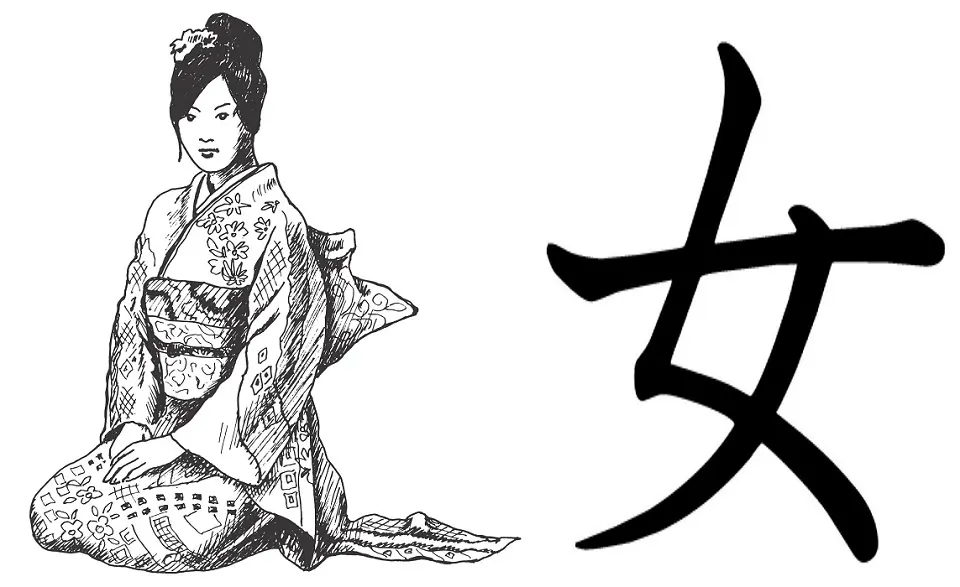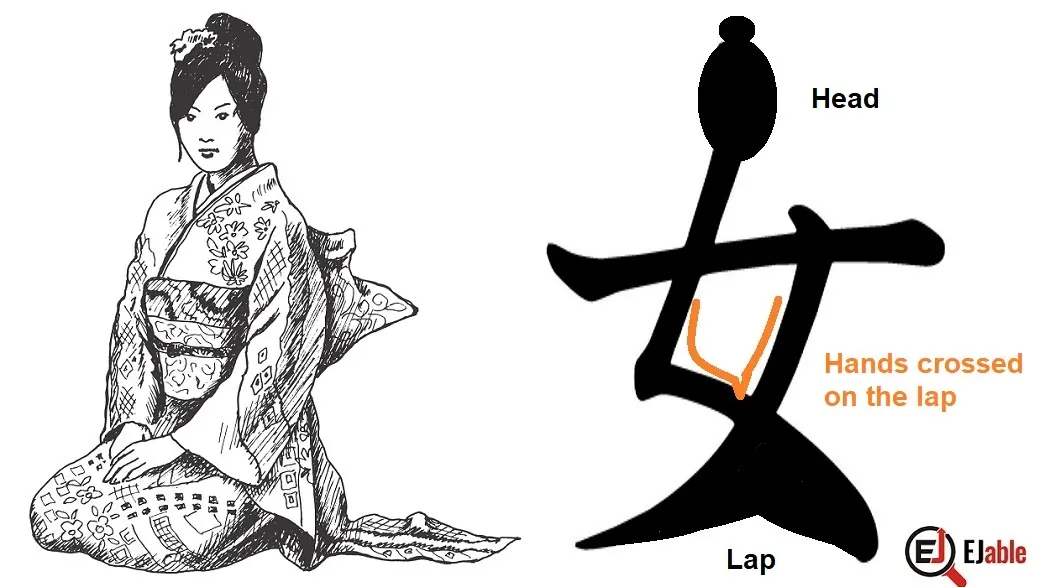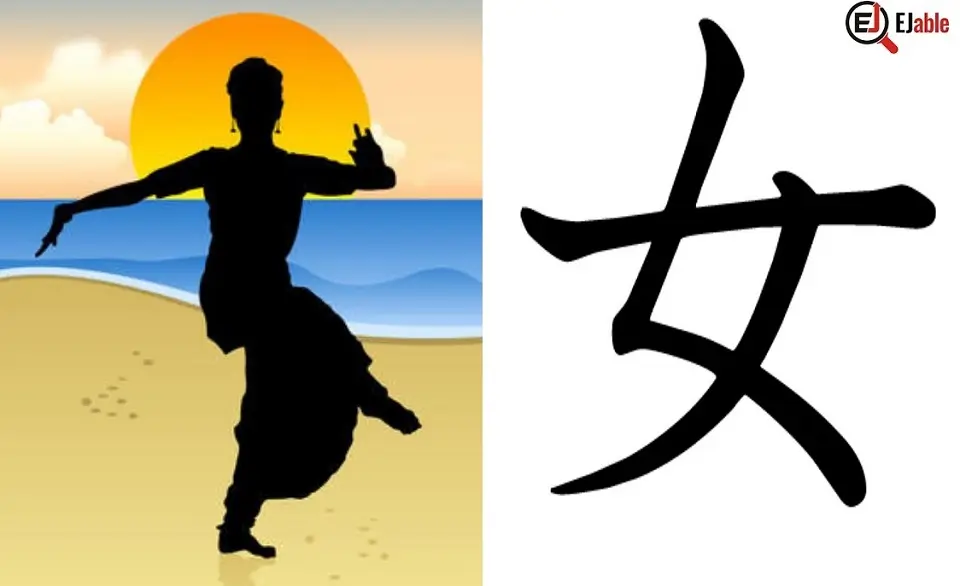Kanji for Woman: 女 (Onna)

The kanji for “Woman” is 女. The Kunyomi or the Japanese pronunciations of the Kanji 女 are “onna” (おんな) and “me” (め), and the Onyomi (Chinese) pronunciations are “jo” (ジョ), “nyo” (ニョ), and “nyo” (ニョウ). Please note that the pronunciation for 女 “me” or “jo” are in compound words.
Woman’s Kanji is constructed with 3 strokes. This Kanji is a part of the JLPT N5 syllabus (please check the JLPT N5 Kanji list). In Japanese schools, this Kanji is taught in grade 1.
Let’s check the origin of the Kanji for women and how to remember it easily.
Origin of the Shape 女
kanji for woman, 女 (onna), is believed to have originated from a pictographic representation of a woman. The shape is a stylized representation of a woman sitting with her hands placed on her lap. This posture was a common posture for women in ancient times.


Over time, this character evolved into its modern form, 女, which continues to depict a woman in a kneeling position, however, in a more abstract way. This progression from a more concrete and pictographic representation to a more abstract one is common in many kanji.
Mnemonic: How to Remember the Kanji of Woman (女)
The above explanation of the Kanji 女, representing a sitting Japanese woman, can help us remember this Kanji. However, this visualization would need to stretch the imagination a bit.
To make it easy to remember, let us consider a common posture depicting a pose of Nataraja in classical Indian dance. This is a very beautiful pose, and having it in memory will make it very easy to remember the Kanji of Woman.
Let’s check the following picture for the visual explanation as an aid to memorizing this Kanji:


Explanation of the Above Visual Representation
- The vertical element at the top of the kanji symbolizes a woman’s poised head and elegant neck.
- The extended horizontal strokes to the left and right evoke the image of the dancer’s arms gracefully spread out in a dance move.
- We can consider the section below these ‘arms’ as the dancer’s torso, lending a sense of human form to the kanji.
- The intersecting lines at the bottom represent the dancer’s legs, crossed in a classic dance position. This pose is evocative of a pose in Indian classical dance such as Bharatnatyam.
Remember, this is a highly interpretative and imaginative way to remember the kanji. However, it doesn’t reflect the true historical origins of the character. Consider it a mnemonic to help easily remember a woman’s kanji (女).
女 as a Radical and Component in other Kanji Characters
The Kanji for woman (女) also appears as a Kanji radical and also as a component in other Kanji characters. 女 appears as a radical or as a component in 396 Kanji characters, including 48 Jōyō Kanji.
The radical for the kanji of the woman (女) is called “onna.” As a radical, it might also be referred to as “onnahen” or “johen”. “Onna” simply means “woman” in Japanese, while “-hen” is a suffix meaning “side” and is often used to refer to radicals. “Jo” is another reading of the kanji for “woman.” So, you might see any of these terms used to refer to this radical.
Examples of 女 as a Radical
- 好 (suki, “like”): This Kanji Combines the kanji for woman and child, suggesting affection.
- 如 (nyo, “likeness”): Uses the woman radical and a character that suggests a mouth or words, possibly to suggest speaking about a woman.
- 妻 (tsuma, “wife”): Combines the kanji for woman and a character meaning “few”, possibly suggesting a single, specific woman.
- 始 (hajime, “begin”): Combines the kanji for woman and a character representing a sprout, possibly suggesting the beginning of life.
- 娘 (musume, “daughter”): Combines the kanji for woman and a character suggesting good or excellence.
- 妹 (imouto, “younger sister”): Combines the kanji for woman and 未. The character 未 (mi) is a prefix meaning “not yet” or still. Therefore, suggesting a younger girl who is still small.
- 姓 (sei, “surname”): Combines the kanji for woman and a character meaning “life”, possibly suggesting family lineage.
- 委 (i, “committee”): Combines the kanji for woman and a character that suggests a roof, possibly suggesting a gathering of individuals.
- 婚 (kon, as in “kekkon” for “marriage”): Combines the kanji for woman and a character meaning “aged”, possibly referring to reaching the age of marriage.
- 姿 (sugata, “figure” or “appearance”): Combines the kanji for woman and a character suggesting a crown or official, possibly implying an elegant or royal appearance.
These interpretations of the combinations of the radical of the woman’s kanji are somewhat speculative. The reason is that the historical development of these combinations may be complex and not fully known.
Woman’s Kanji (女) in Compounded Words
The Kanji for the woman 女 frequently appears in compounded Japanese words’ kanjis. There are 301 Japanese words that begin with the Kanji 女, and it appears in 567 words.
Please note that in most of the compounded words, the Kanji 女 is pronounced as “jo” (じょ). However, there are words where 女 is pronounced as onna or me (め).
Examples of Kanji 女 in Compounded Kanji Characters
Following are the examples where Kanji for woman appears in Japanese compounded Kanji characters:
- 女性 (じょせい, josei): Woman, female.
- 女子 (じょし, joshi): Girl, young woman.
- 女王 (じょおう, joō): Queen.
- 女優 (じょゆう, joyū): Actress.
- 女性的 (じょせいてき, joseiteki): Feminine.
- 女の子 (おんなのこ, onnanoko): Girl.
- 女子会 (じょしかい, joshikai): Girls’ gathering or meeting.
- 女子校 (じょしこう, joshikō): Girls’ school.
- 女性化 (じょせいか, joseika): Feminization.
- 女神 (めがみ, megami): Goddess.
- 女房 (にょうぼう, nyōbō): Wife (old-fashioned term).
- 女心 (おんなごころ, onnagokoro): Woman’s heart/mind.
- 女手 (おんなで, onnade): Woman’s hand; woman’s help or work.
- 女子力 (じょしりょく, joshiryoku): Women’s strength/charm; often used to refer to a woman’s ability in traditionally feminine roles or skills.
- 女子高 (じょしこう, joshikō): Girls’ high school.
These examples illustrate the diverse contexts for “woman” or “femininity” in Japanese, highlighting aspects of gender identity, social roles, and cultural perceptions.
Difference Between Two Kanji for Woman 女 (Onna) and 女性 (Josei)
The difference between 女性 (じょせい, josei) and 女 (おんな, onna) lies primarily in their usage and connotations in the Japanese language:
女性 (じょせい, josei):
- 女性 (Josei) is a more formal term akin to “lady” in English.
- It is often used in more official or formal contexts, such as in discussions about gender roles in demographics or formal writing.
- The term is neutral and can respectfully refer to adult women.
- “女性” is also part of many compound words related to women’s issues, roles, or descriptions, like 女性化 (joseika, feminization) or 女性的 (joseiteki, feminine).
女 (おんな, onna):
- 女 (Onna) is a more general term for “woman” or “female.”
- We can use Onna for women in everyday conversation, and it is less formal than 女性.
- While it can refer to adult women, the context in which it’s used often determines the exact meaning.
- “女” is also used in compound words and phrases but can have a broader range of applications, including colloquial expressions.
In summary, while both terms refer to women or females, 女性 is typically used in more formal or specific contexts, whereas 女 has a broader and more general usage. The choice between the two depends on the level of formality and the specific context of the conversation or text.
Do check other Kanji characters on the page “How to Remember Kanji“.


A long-term ex-pat in Japan, Himanshu comes with an IT background in SAP consulting, IT Business Development, and then running the country operations of an IT consulting multinational. Himanshu is the co-founder and Managing Director of ReachExt K.K. and EJable.com. He is also an Advisory Board Member of a Silicon Valley AI/IoT startup.

